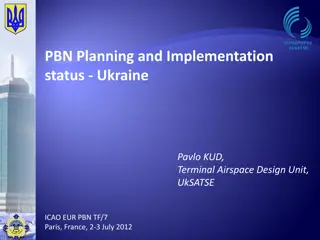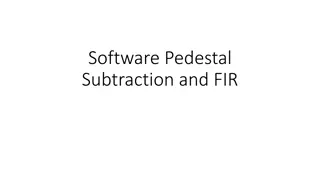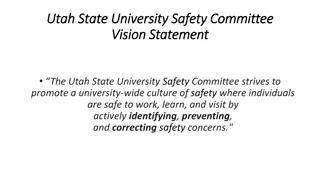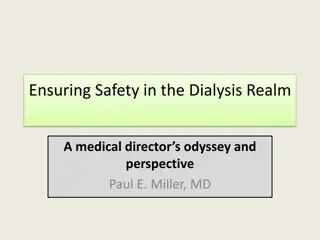HIT Implementation Planning for Quality and Safety Lecture
This material, developed by Johns Hopkins University and funded by the Department of Health and Human Services, focuses on HIT implementation strategies for quality and safety improvement. It covers topics such as big bang vs. staggered approaches, go-live support, maintenance strategies, contextual implementation models, and differences between implementation methods. The content emphasizes factors influencing successful implementation at organizational, clinical unit, and individual levels.
- Quality Improvement
- HIT Implementation
- Johns Hopkins University
- Health Information Technology
- Safety Planning
Download Presentation

Please find below an Image/Link to download the presentation.
The content on the website is provided AS IS for your information and personal use only. It may not be sold, licensed, or shared on other websites without obtaining consent from the author. Download presentation by click this link. If you encounter any issues during the download, it is possible that the publisher has removed the file from their server.
E N D
Presentation Transcript
Quality Improvement HIT Implementation Planning for Quality and Safety Lecture b This material (Comp 12 Unit 8) was developed by Johns Hopkins University, funded by the Department of Health and Human Services, Office of the National Coordinator for Health Information Technology under Award Number IU24OC000013. This material was updated in 2016 by Johns Hopkins University under Award Number 90WT0005.. This work is licensed under the Creative Commons Attribution-NonCommercial-ShareAlike 4.0 International License. To view a copy of this license, visit http://creativecommons.org/licenses/by-nc-sa/4.0/.
HIT Implementation Planning for Quality and Safety Learning Objectives Lecture b Assess the quality implications of big bang versus staggered approaches to activation. Discuss go live support strategies that minimize risk. Discuss post live maintenance support strategies. 2
Implementation Strategies: The Big Bang 3
Implementation Strategies: Staggered (Phased) 8.04 Figure. 4
Implementation Strategies: Differences Big Bang: Fast implementation. Short-lived anxiety. Quicker ROI. Shorter timeframe. Maintain momentum. Fewer hybrid systems. High risk, high anxiety. Large scope. Greater resource needs. Incremental: Less likely to erupt. Less anxiety. Greater manageability of incremental units. Slower. Longer time for ROI. Higher training costs. Potential for stagnancy. 5
Contextual Implementation Model (CIM) Implementations: ongoing, iterative. Three contextual levels of differences: Organizational context. Clinical unit context. Individual context. 6
Contextual Implementation Model: Organizational Context Organizational context: Organizational culture. Resources. IT experience. Size and location. Implementation life cycle stage. Mission and strategic plan. Organizational structures. Roles of clinicians (doctors, nurses). Leadership. 7
Contextual Implementation Model: Clinical Unit Context Clinical unit context: Team culture. Unit leadership. IT experiences. Clinical profile of unit. Size. User attitudes regarding use of IT. 8
Contextual Implementation Model: Individual Context Individual context: Diverse ways of working. Diverse ways of thinking. Diverse ways of communicating. Diverse ways of collaborating. Computer literacy. Keyboard skills. 9
Complex Systems Diverse interactions and self-organization are critical. A certain level of noise, creativity, and exploration should be expected for learning, changing, and adapting. Effective structures are essential. 10
Complex Systems Structures: Health System Strategic oversight team. Centralized matrix leadership. Nested expert teams. Hospital oversight teams. Project management teams. Centralized trainers. 11
Complex Systems Structures: Nested Teams 1 Operational teams: Operations oriented. Standardize operational processes/patient safety practices. Clinical discipline teams: Membership of a single professional discipline. Addresses professional standards. 12
Complex Systems Structures: Nested Teams 2 Clinical consensus teams: Multidisciplinary. Standardize practices related to specific patient populations or problems. Problem-oriented ad hoc teams: Short term, rapid action. Addresses specific problems or interests. 13
Implementation Support External consultants: Implementation specialists. Trainers. Internal consultants: Super-users/coaches/mentors. Support pools. 14
Implementation Support: External Consultants Have expertise in use of the particular software application. Have experience on go-live teams in a wide variety of settings. Have the dedicated time to support the implementation. Less familiar with the specific organizational policies and workflows. More costly than using internal consultants. 15
Implementation Support: Internal Consultants 1 Clinical personnel. Have training and knowledge beyond the usual end user for the given software application. Link the clinical world with the IT world. Have a variety of titles: super-users, coaches, mentors. Informal or formal roles. 16
Implementation Support: Internal Consultants 2 Serve as champions for the new system. Promote adoption. Assist with/reinforce training. Assist with developing policies and procedures, including downtime. Liaison between clinical and IT staff. Perform competency testing. Provide quality oversight. 17
Implementation: Factors that Affect Success 1 It is not possible to designate a single implementation strategy that works in all settings. End user support (or lack thereof) is a significant factor in both successful (and failed) implementations. Long-term attention to end-user training and support is the key to data quality. 18
Implementation: Factors that Affect Success 2 There should be skilled resource people: Present on the unit. Able to provide quick help. Serve as a driving force for change. Responsible for training. Formal post implementation support and training. 19
HIT Implementation Planning for Quality and Safety Summary Lecture b No single best way to implement HIT. Contextual factors are important for implementation planning. End-user education and support are critical to success. Long-term training and support drive quality. 20
HIT Implementation Planning for Quality and Safety References Lecture b 1 References Callen, J., Braithewaite, J., & Westbrook, J. I. (2008). Contextual implementation model for assisting clinical information system implementations. Journal of the American Medical Informatics Association, 15(2), 255 262. Gruber, D., Cummings, G. G., Leblanc, L., & Smith, D. L. (2009). Factors influencing outcomes of clinical information systems implementation: A systematic review. CIN: Computers, Informatics, Nursing, 27(3), 151 163. McNeive, J. E. (2009). Super users have great value in your organization. CIN: Computers, Informatics, Nursing, 27(3), 136 139. Owens, K. (2008). EMR implementation: Big bang or a phased approach? Journal of Medical Practice Management, 23(5), 279 281. Panorama Consulting Group. (2006). ERP s Big Bang theory. Retrieved May 27, 2016, from http://panorama-consulting.com/erps-big-bang-theory/ Scott, K., & Van Norman, J. (2009). Managing the complexity of a systemwide electronic medical record design and implementation: Lessons for nurse leaders. Nursing Administration Quarterly, 33(2), 109 115. 21
HIT Implementation Planning for Quality and Safety References Lecture b 2 Charts, Tables, Figures 8.04 Figure: Phase Diagram. Courtesy Alan J. McCombs. Johns Hopkins University. Images Slide 3: The Universe's Baby Picture. Courtesy NASA. Retrieved May 27, 2016, from http://science.nasa.gov/astrophysics/focus-areas/what-powered-the-big-bang 22
Quality Improvement HIT Implementation Planning for Quality and Safety Lecture b This material (Comp 12 Unit 8) was developed by Johns Hopkins University, funded by the Department of Health and Human Services, Office of the National Coordinator for Health Information Technology under Award Number IU24OC000013. This material was updated in 2016 by Johns Hopkins University under Award Number 90WT0005. 23
















































